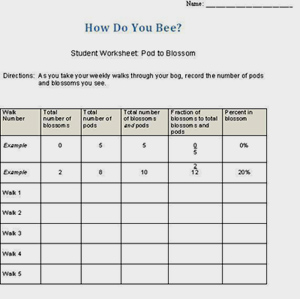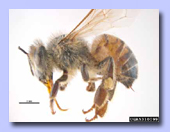|
Lesson Plan:
Overview
Background
Materials
Preparation
Step-by-Step
|
- Introduce this lesson, considering the following points:
- If you have implemented Bugs on the Bog, introduce this lesson by making a connection to it: There’s more to insect management than just keeping down the population of insect pests and the damage they cause. Point out that many insects help maintain overall ecosystem health in the bog area, and that others are crucial to the bog.
- Introduce the honeybee and other insect pollinators as examples of extremely important insects for the bog.
- Let students know that their challenge will be to manage the use of bee pollinators on their bog to realize the best benefits with the fewest detriments.
- Review or provide a brief overview of pollination:
- View Part 1 of the How Do You Bee Teacher PowerPoint
- Make sure that students understand that the plant needs to go through its entire cycle to make a berry. If seeds don’t form, then there’s no berry. To form seeds, pollen has to move from one flower to another, where it later combines with a sort of pre-seed, called an ovule.
- Tell students that growers don’t rely on local insects alone to pollinate the cranberry flower. Instead, growers rent or buy bee hives. They get the hives only when the right amount of flowers are in bloom.
- Direct students to the student web resource, Cranberry Uprights and project an image from your computer for the class to see (this image appears in Part 2 of your Teacher Resource PowerPoint). Use the first slide to show students how to identify pods. (See Background)
- Conduct a whole class discussion by asking students to examine the image of the uprights and make the following observations:
- How many pods do you notice on each upright?
- What differences do you see in the pods?
- What else do you see besides the pods?
- Do you notice any patterns?
- Have the class advance to the next slide. Direct students to make an observational drawing of one of the uprights and label the pods and blossoms. Inform students that they will refer to these drawings later in the lesson.
- When students have completed their drawings have them advance to the next slide to check the accuracy of their pod and flower labeling.
- Advise students that they will now turn their attention to renting bees for pollinating their adopted bog. Distribute the Bizzy Bee Order Form to the students.
- Read and discuss the order form. If students have not done so, point out the weather forecast included in the order form. Have students identify the decisions they will need to make to successfully complete the order form:
- When the bees should arrive on the bog.
- How long the bees should stay on the bog.
- Which bee (honey bee, bumblebee, both?) should be ordered.
- Explain to students that they will use several resources to help them make these decisions.
- Project the first image of Part 3 of your Teacher Resource PowerPoint, the Peak Pollination Graph. Ask students to describe the graph.
- What is happening to the shape of the graph?
- What other information do you see?
- How can that information help you to understand this graph?
- Guide students to the understanding that this graph shows the rate at which bees pollinate cranberry blossoms.
- Project the next image of the Peak Pollination Graph, which is an overlay of the first. Ask students:
- How has the graph changed?
- What new information do you see?
- What is happening where the cranberry line and the weed line cross?
- Hold a Growers’ Association Meeting. Distribute Growers’ Association Brief, The Buzz on Bees
- Read and discuss; make sure to address the following points:
- How does a grower know when it’s a good time to have bees delivered on the bog?
- What happens if the bees are delivered too early?
- What happens if they stay too long?
- What happens if it’s rainy? What happens if it’s sunny?
Make sure that students understand that the optimal time for bees to arrive is when the level of flower bloom reaches 10% (or 5 flowers out of a total of 50 flowers and pods). If the bees arrive on the bog too early, there won’t be enough flowers to pollinate. In that event, the grower will need to keep the hives for a longer time period to achieve maximum pollination and therefore berry production. Because the grower pays a rental fee for the hives, s/he aims to rent the hives for the shortest amount of time needed to ensure the greatest possible harvest.
In addition, there are risks in allowing the bees to stay too long on the bog. Their continuing presence might interfere with a pest management plan. Also, if the peak cranberry flower bloom has passed, bees may not find enough nectar and pollen in the cranberry bog. This may cause them to visit nearby plants--including weeds. This can lead to increased weed growth next season.
- Direct students to the appropriate student resource, Walking the Bog
- Distribute and review the Student Worksheet: Pod to Blossom (An excerpt from the table appears below). Explain to students that for each walk (numbered on the sheet), they are to examine the images of the cranberry uprights (from Walking the Bog) and tally all of the blossoms. Students should record this number in the 2nd column labeled, Total number of blossoms. Next, students should count only the pods and record that number in the Total number of pods column. Record the total number of blossoms and pods in the 4th column. The ratio of blossoms to the total number of blossoms and pods is expressed as a fraction in the 5th column and as a percentage in the final column.

- Note: At the end of Walk 3, there is a stop sign in the student presentation. Bizzy Bee Farm(the hive supplier) has called and is asking you when you want your bees. Advise students that they must commit to a date when the bees should arrive: immediately, week #4, week #5, or even later. Prompt students to base their decision on the information provided in the Peak Pollination graph, the Growers’ Brief, and their bog walk data.
- In addition, students must decide which bee to order: honey bees for rental, bumblebees for purchase, or a combination of both.
- Finally, students must decide when the bees should leave the bog.
- Reconvene the Growers Association Meeting. Invite students to share their decisions. As a class, review the feedback provided in Part 4 of the Teacher Resource PowerPoint and discusses surprises and enduring questions. What student decisions overlap with the feedback provided by growers? What would the experienced growers have done differently from the students?
|




